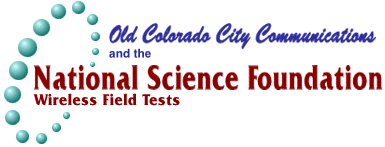
|
Voice 719.636.2040 · Fax 719.528.5869 ·Wireless Web http://wireless.oldcolo.com | ||
|
|
             |
Progress Report 16November 14th, 1997
Thirty Two Wireless Miles to San Luis At 11:30 AM, Thursday the 13th of November, the 32 mile wireless link between AmigoNet of Alamosa, and the Centennial School District of the small town of San Luis, Colorado, came to life. It was the toughest of all the links initially proposed by this NSF Wireless Field Test Project to accomplish, for it involved not only the longest distance of any tried, and was attempted with the lowest cost radios delivering an adequate signal - 115Kbps - it had to contend with a typical case of 'no line of sight' between the closest Internet provider and the school which is tucked away at the bottom of a valley in the town. It had to go over a 300 foot ridge towering above the town. Presently we will post a map and schematic of the link here so you may vizualize the layout, and radio-router architecture. But suffice it to say, the Internet wireless connection: 1. Starts from a yagi antenna on a 60 foot tower at Amigo Net's premises on Main Street in Alamosa. 2. Traverses 30.2 miles of the valley floor across the bleak sand, sage, the Rio Grande river near its headwaters, from approximately 7,000 to 9,000 feet of elevation. 3. Clears a ridge at 30 miles by only 10 feet, which introduces the 'Fresnel' edge effect which can diffuse the radio signal. The effect of beams passing over an edge which diffuses the power. 4. Reaches the second yagi antenna 95 feet up on the Sheriff's radio tower sitting on a shelf visible to the town of San Luis. But then must travel down an LMR-400 quality RF cable over 160 feet - with perhaps 6dB of loss - into a radio shack where the radios and router using wall power sit. 5. Into FreeWave 115DRG Radio #1 which is in the Point to Point mode talking only to the radio in Alamosa. Then via COM1 serial line into a Debian Linux router. Through the router which points to all the appropriate IP directions and gateways, out COM2 to Radio #2. 6. Radio #2 goes via 15 feet of RF cable to an Omni antenna on the roof of the shack, most of which is visible over the edge of the shelf above the town to the town and the small ranches and homes and communities stretching to the 14,000 foot Sangre de Cristo range. 7. The radio communicates with an antenna on the roof of Centennial School District about 1 mile away, which is linked by RF cable to a radio in the 'Communications Room' of the school, where all the ethernet lines terminate in hubs and the NT Server serving the school. 8. The radio goes into our NSF Linux router's COM1, which is linked to the NT 4.0 server by Ethernet into the hub. 9. The Internet signal is then distributed throughout the school, via the NT server's Ethernet connections to Windows 95 workstations each of which uses DHCP dynamic IP allocation. Thus all workstations, when booted up, have a continuous IP connection through the LAN and two radio links to the routers of Amigo Net in Alamosa. And can use all functions such as ping, telnet, ftp, and Web. When I left the school early because of incoming snow weather for the 150 mile trip back to Colorado Springs, Hispanic students in their small (350) K-12 school district were surfing the net and downloading upgrades to Win95 Explorer, from at least 7 workstations. And when I did a traceroute, the total delays through 21 hops of the Internet appeared to be about 250ms. With no cost to the school for the 32 direct, or 45 roadmile link to Alamosa, the costs of their connection to a commercial POP in Alamosa, Amigo Net, is under $300 a month, rather than the $600 or more had the link been via the Telco at half the speed (56kbps) unless a T-1 were ordered - which would over $2,500 a month ($1,700 for the Telco T-1, and $800 for ISP T-1 service). This configuration of the use of the school's wireless link will presently change to serve the entire Community of San Luis, upon which I will report, when implemented. For that will involve a Point to Multipoint arrangement of other radios across the town.
Dave Hughes 

|

